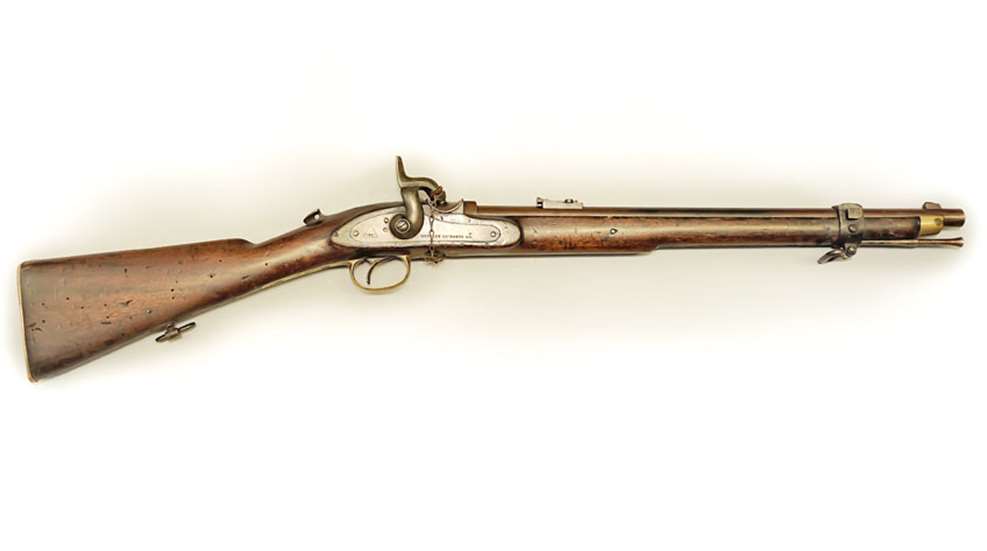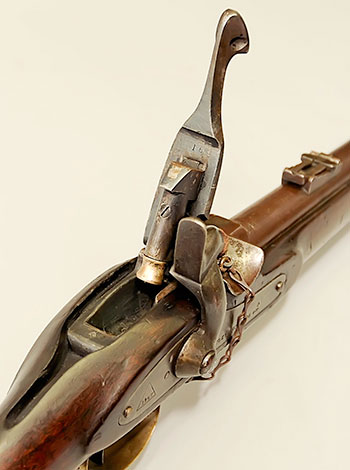
 As early as the 1850s, the British Board of Ordnance, recognizing breechloading firearms were the coming thing, began a search for a breechloader with which to arm its cavalry regiments. Evaluations of foreign and domestic designs began in earnest, with most of the non-English models originating from the United States.
As early as the 1850s, the British Board of Ordnance, recognizing breechloading firearms were the coming thing, began a search for a breechloader with which to arm its cavalry regiments. Evaluations of foreign and domestic designs began in earnest, with most of the non-English models originating from the United States.
Many systems were tested and discarded. Others, such as a pair of .577-cal. variants of the Model 1855 Sharps carbine and the British Calisher & Terry bolt-action, were even provisionally adopted and issued to selected regiments for in-the-field trials.
To ensure that all its mounted troops had reasonably up-to-date arms, a stopgap carbine version of the Pattern 1853 Enfield muzzleloader (November 2018, p. 96) was adopted and distributed. In the meantime, authorities continued looking.
In 1858, the respected Birmingham, England, gunmaking firm of Westley Richards received a patent for a unique capping breechloader. The action involved a top lever that, when lifted, exposed the chamber for the insertion of a special paper cartridge. This round incorporated a greased felt wad on its base, which helped with sealing and also lubricated the bore when pushed forward by the next shot. The lever, when opened, was thought by some to resemble a monkey’s tail. The jape stuck and would become the sobriquet by which the gun would thenceforth unofficially be referred.
To assist in sealing, a brass-faced sliding plunger arrangement was affixed to the inside of the lever. When the gun was fired (using a separate musket-size percussion cap), the plunger assembly was pushed backward where it locked the action. The carbine employed a barrel with an octagonally rifled variation of Sir Joseph Whitworth’s famed polygonal bore.
In 1860, Westley Richards submitted the “Monkey Tail” to the War Dept., which thought the gun had promise, but found fault with some features. It was back to the drawing board for the people at Westley Richards—four times in fact—before a fifth pattern of the gun would be officially accepted in 1866.

Simply put, it was a superb arm—very probably the most sophisticated capping breechloader to see service anywhere. Carbines used by Her Majesty’s forces were made at Enfield, but Westley Richards itself built and sold sporting rifle and carbine versions and made them under contract for Portugal.
For the British at least, production of the Monkey Tail came along too late for its potential in the field to fully be realized, as in 1866 the War Dept. also adopted the simpler Snider breechloading system, which chambered a self-contained metallic cartridge. Westley Richards carbines remained in service for a time, but were replaced by Sniders.
Portugal, however, had no problem keeping the guns in its arsenals for a considerable period, and ordered many thousands of rifles and carbines, though the country, which had a long association with Great Britain, also took up Sniders in the mid-1870s. It is a Portuguese variant we’re looking at here. Portuguese Monkey Tails are the most common types seen on the collector market, as large numbers were imported into the United States by Golden State Arms in Pasadena, Calif., in the 1950s and ’60s.
These guns, marked with Westley Richards’ address and Whitworth’s patents, are easily recognized by an “FA” (Forças Armadas—“Armed Forces”) and storekeeper’s date stamped in the stocks. As well, all the carbines are “artillery-style” and feature a bayonet lug on the barrel band and standard sling swivels.
Originally sold by Golden State Arms for $24.95, today a Portuguese Monkey Tail Carbine in good condition is worth in the $850 to $1,450 range. A British military-issue Westley Richards No. 5 Carbine would run about twice as much.
Gun: Westley Richards Carbine, Pattern No. 5
Manufacturer: Westley Richards & Co.
Caliber: .451
Manufactured: 1867 (Portuguese Contract)
Condition: NRA Very Good (Antique Gun Standards)
Value: $850 to $1,450



































